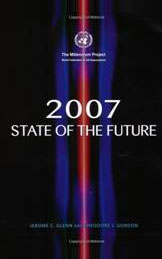DYNAMIND - WORLD AWAKENS
Extracts from book: (Emphasis on extracts are ours)
THE MILLENNIUM PROJECT
World Federation of UN Associations
In the ‘Millennium Project, World Federation of UN Associations’.
The book titled ‘2007 STATE OF THE FUTURE’. Author Jerome
C. Glenn and Theodore J. Gordon talks about the Future Possibilities For
Education AND Learning By THE Year 2030. Below are some excerpts, followed
by i2K’s comments on how dynamind meet these rquirements today.
(Page 57)
Sub title: National programs for improving collective intelligence.
CI will become a new buzzword, with major academic institutions
using it as a strategic research focus and demonstrating that it is the
next logical step in social-technological evolution.
(Page 59)
Sub title: Just-in-time knowledge and learning
Much of traditional education will be replaced by Web-based, managed learning
provided by open source collaboratives or vendors who compete in delivering
measurable knowledge acquisition and retention, with speed and effectiveness
as the basis of payment. Teachers and students must be part of a team
where the teacher is coordinator of information collection.
(Page 60)
Sub title: Individualized education
The convergences of advances in the Internet, cognitive sciences, medicine,
artificial intelligence, continuation of Moore’s Law, just-in-time
learning, and the success of the $100 laptop will make this more available.
If facilitated by mentors, it could be the core of the new educational
paradigm. The proper use of IT and “coaching on-line”
to address individual learning not only in elementary, secondary, and
tertiary education but also of adults for “life-long learning”
should be included.
(Page 75)
Sub title: E-Teaching
Most of the poorer areas in 2030 as well as the more affluent ones use
global outsourcing for e-teachers on-demand. These e-teachers are increasingly
artificial constructs using artificial intelligence rather than live humans17.
E-teaching will help education to become more democratic, increase access
to more people around the world, reduce financial and environmental costs
per student and thus help reduce poverty, popularize science and culture,
increase the joy of learning, facilitate the exchange of information among
educational institutions, and open new methods of education. It will
also lead to customized one-on-one instruction and make knowledge
acquisition easier, faster, more individualized, virtual, and globalized.
The live teacher is one of the least efficient and perhaps least effective ways of teaching; artificial constructs will become more and more the norm.
